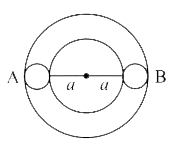Six steel balls of identical size are lined up along a straight frictionless groove. Two similar balls moving with speed v along the groove collide with this row on the extreme left end. Then
one ball from the right end will move on with speed v
two balls from the extreme right end will move on with speed v and the remaining balls will be at rest
all the balls will start moving to the right with speed v8
all the six balls originally at rest will move on with speed v6 and the incident balls will come to rest.
The correct Answer is:B
Step by step video, text & image solution for Six steel balls of identical size are lined up along a straight frictionless groove. Two similar balls moving with speed v along the groove collide with this row on the extreme left end. Then by Physics experts to help you in doubts & scoring excellent marks in Class 11 exams.
Updated on:21/07/2023Topper's Solved these Questions
- WORK , ENERGY & POWER Book:NARAYNAChapter:WORK , ENERGY & POWER Exercise:EXERCISE - 1 (C.W)
Explore 70 Videos
- WORK , ENERGY & POWER Book:NARAYNAChapter:WORK , ENERGY & POWER Exercise:EXERCISE -1 (H.W)
Explore 60 Videos
- WORK , ENERGY & POWER Book:NARAYNAChapter:WORK , ENERGY & POWER Exercise:(C.U.Q ) MOTION IN A VERTICAL CIRCLE
Explore 6 Videos
- WAVESBook:NARAYNAChapter:WAVESExercise:Exercise-IV
Explore 56 Videos
- WORK POWER AND ENERGYBook:NARAYNAChapter:WORK POWER AND ENERGYExercise:Level-VI (Integer)
Explore 12 Videos
Similar Questions
Six steel balls of identical size are lined up long a straight frictionless groove. Two similar balls moving with a speed V along the groove collide with this row on the extreme left hand then-

View SolutionFour smooth steel balls of equal mass at rest are free to move along as straight line without friction. The first ball is given a velocity of 0.4m/s It colloids head on with the second elastically, the second one similarly with the third and so on. the velocity of the last ball is :
View Solution
Knowledge Check
STATEMENT - 1 : Two identical balls B and C lie on a horizontal smooth straight groove so that they are touching. A third identical ball A moves at a speed v along the groove. And collides with B as shown in figure. If the collisions are perfectly elastic, then after the collision, balls A and B will come to rest and ball C moves with velocity v to the right.
because

STATEMENT - 2 : In an elastic collision, linear momentum and kinetic energy are both conserved.AStatement - 1 is True, Statement - 2 is True, Statement - 2 is a correct explanation for Statement - 1.BStatement - 1 is True, Statement - 2 is True, Statement - 2 is NOT a correct explanation for statement - 1.CStatement - 1 is True, Statement - 2 is False.DStatement - 1 is False, Statement - 2 is True.Two similar trains are moving along the equational line with same speed but in opposite direction. Then :
Athey will exert equal force on railsBthey will not exert any force as they are on equatorial lineCone of them will exert zero force.Dboth exert different forcesFour smooth steel balls of equal mass at rest are free to move along a straight line without friction. The first ball is given a velocity of 0.4 m/s . It collides head on with the second elastically, the second one similarly with the third and so on. The velocity of the last ball is
A0.4m/sB0.2m/sC0.1m/sD0.05m/s
Four smooth steel balls of equal mass at rest are free to move along as straight line without friction. The first ball is given a velocity of 0.4m/s It colloids head on with the second elastically, the second one similarly with the third and so on. the velocity of the last ball is :
View SolutionA steel ball of radius 2cm is at rest on a frictionless surface. Another ball of radius 4cm moving at a velocity of 81cm/see collides elast cally with first ball. After collision the smaller ball moves with speed of
View SolutionA steel ball of radius 2cm is at rest on a frictionless surface. Another ball of radius 4cm moving at a velocity of 81cm/sec collides elastically with first ball. After collision the smaller ball moves with speed of
View SolutionTwo identical spheres A, B are in a smooth horizontal circular smooth groove at opposite ends of a diameter. A is projected along the groove and it impinges on B in a time interval T. Let e be the coefficient of restitution, the

View SolutionTwo identical spheres P and I lie on a smooth horizontal circular groove at opposite ends of diameter. Pis projected along the groove and at the end of time t, impinges on Q. If e is coefficient of restitution, the second impact will occur after a shortest time of
View Solution

